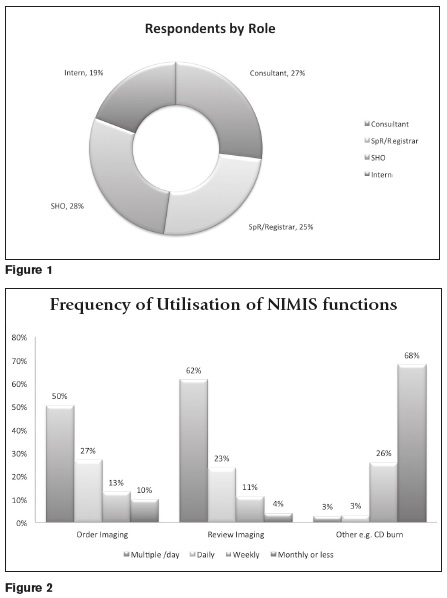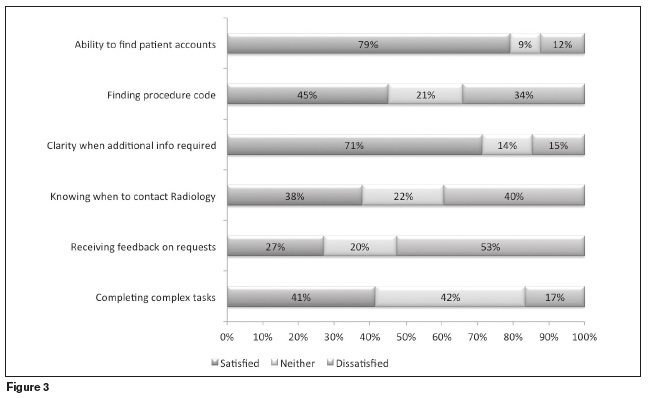Introduction
The implementation of electronic picture archiving and communication systems (PACS) for storing radiological images has vastly improved the quality and accessibility of such studies. The National Integrated Medical Imaging System (NIMIS) is a system for storing and retrieving medical imaging studies in Ireland comprising a national Radiology Information System (RIS) and PACS, with imaging studies stored both locally and at a central data repository. At the time of this audit, NIMIS was live in 34 sites in Ireland, with a number of further sites planned. The NIMIS RIS allows end users to order and review imaging from their current hospital site, whilst the PACS interface permits access to imaging performed across all NIMIS sites. This audit focuses on the use of the RIS system in individual hospitals on a day-to-day basis, which has not been previously analysed on a national level. To date, analysis has focused on the NIMIS rollout across the many Irish sites and there appeared to be an opportunity to examine the end-user experience of this widely used and relied upon system.
The aim of this study was to obtain direct feedback from the end-users of the NIMIS system in relation to key areas of functionality. The objective of the audit was to highlight the perceived advantages and disadvantages of NIMIS and its existing interface. A secondary aim was to gather suggestions about potential improvements directly from NIMIS users. It was hoped that in doing so, the findings could form the basis for a process of continuing end-user acceptance testing and improvement. In interpreting the results of this study it is important to be cognizant of the fact that a number of the sites utilising NIMIS do so via their own local version of RIS. This local RIS is used to access NIMIS and, in some cases, links with other local patient-centred IT systems. As such, there will be a degree of variation in the end-user experience in centres where an alternative RIS is utilised. It is also important that to bear in mind that, in looking at the McKesson RIS, the focus is on the Horizon Rad Station Distributed client. This client is the Java-based front-end utilised by the majority of users to access NIMIS. As a result the Horizon Rad Station Advanced client, more commonly used by Radiologists, does not fall within the scope of this survey.
Methods
The “NIMIS End-User Experience” survey was created using an online service provider. It addressed a number of key areas of NIMIS functionality, performance and end-user satisfaction. In order to complete the survey, a list of the 34 live NIMIS RIS sites was obtained from the system provider (McKesson). The Medical Manpower department in each of the live sites was contacted and asked if they would be willing to send the survey to their Consultants and NCHDs. Of the 34 sites invited, 28 agreed to allow doctors employed at that site to participate. A total of 278 responses were obtained. Of these responses 16 were incomplete and two responses were duplicates. This yielded a total of 260 complete responses across various roles [Figure 1].

Results
NIMIS RIS allows users to order and review imaging for patients at their current site. The first step in gaining access to the local RIS is to obtain appropriate login credentials. Respondents were asked to indicate how long it took them to gain access to their local NIMIS. Of the 260 respondents, access was granted immediately for 51% (133) and within three days for 27% (69). A further 8% (20) obtained access within the first week while the final 15% (38) were waiting longer than a week. The survey also examined the primary NIMIS functions and the frequency with which the respondents used them [Figure 2]. In relation to both ordering and reviewing images, it was found that these functions were utilised at least once per day by 77% and 85% of respondents respectively. Of the 260 respondents, 46% utilised NIMIS solely for the purpose of ordering or reviewing imaging. The remaining 54% of respondents utilised other NIMIS functions (e.g. CD burning) but on a weekly to monthly basis at most.
The survey asked respondents to indicate their satisfaction with key NIMIS functionsand in relation to communicating with the Radiology department [Figure 3]. When surveyed, 79% of respondents were satisfied with their ability to find patients’ NIMIS accounts, while only 12% were dissatisfied. However 34% were dissatisfied with regards to finding the appropriate procedure code for their request, compared to 45% of users who were satisfied with performing the same task. Of the respondents, 71% felt that there was sufficient clarity when additional information was required. However, 47% of respondents were unsure when further documentation was required to support a request. The survey found that 41% of users were satisfied with completing complex tasks, while 42% were neither satisfied, nor dissatisfied. This reflects the results above which indicated that 68% of respondents rarely, if ever, use NIMIS beyond the image ordering and reviewing functions. With regard to NIMIS facilitating communications with the Radiology department, 38% of users felt that it was clear when they needed to contact the department in relation to a request. A further 40% felt that they did not know when this was necessary. The survey asked users to indicate their level of satisfaction with regards to receiving feedback on outstanding requests. Of the respondents, 27% were satisfied while 53% were dissatisfied with the feedback received.

Additionally, the survey assessed what technical support users felt was available to them and what support, if any, they would access if experiencing difficulty with NIMIS. Of the respondents, 59% felt that there was some form of technical support available to them at their NIMIS location. The survey then looked at which personnel or department users would approach with regard to NIMIS queries or support issues. This demonstrated that the most junior members of the team were more likely, at 68%, to seek help from peers and senior colleagues. Conversely, they were also the least likely to avail of support from Radiology (16%) or the PACS Office/Technical support (18%). It was noted that these trends reversed with increasing seniority. As a result, 17% of Consultants indicated that they would seek help from peers or junior colleagues while this same group was increasingly likely to seek help directly from Radiology (23%) or from PACS Office/Technical support (35%).
Finally, the survey allowed users to provide free-form feedback, comments and suggestions regarding their end-user experience of NIMIS. Overall there was a mixed response among those surveyed about their end-user experience of NIMIS although most respondents were keen to see NIMIS utilised by more clinical sites in order to promote clinical collaboration between institutions. Furthermore, respondents were generally very pleased with the existing PACS functionality. Many respondents felt that integrating RIS and PACS into a single system would be of great clinical benefit. Many respondents, while happy with overall functionality, indicated that areas exist in which the design and functionality of NIMIS could be improved. Additionally many felt that there is a need for NIMIS to support improved communication between end-users and Radiologists in relation to outstanding requests. With regard to IT and infrastructure, respondents expressed concerns over the suitability of current hardware and the supporting network to allow efficient use of NIMIS. NIMIS RIS is a web-based application and hence most of the performance limitations would appear to be due to network latency and bandwidth. The respondents have suggested that improvements in IT and infrastructure would greatly decrease the time taken to order or review imaging. Patient records on NIMIS are accessed using a Medical Record Number (MRN) specific to the current site. The patient record allows the user to place new orders or review existing imaging and reports completed at that site. The respondents identified a need for a unique NIMIS identifier for patients to eliminate the need to manually search for a specific patient on PACS.
Imaging is ordered via the RIS patient record and an inpatient; outpatient or Consultant-specific account for that patient must then be selected. The survey has highlighted concerns regarding these accounts. Many respondents felt that a scan could be ordered on the wrong account and would subsequently be rejected. Additionally, a “ward attender” must be created in order to allow an outpatient scan to be booked for a patient under a specified Consultant. Most RIS users do not have permission to create a “ward attender” and this can delay ordering follow-up imaging for patients on discharge from hospital. Furthermore, respondents have suggested that allowing users to access both the ordering function and reviewing function simultaneously would increase end-user satisfaction and allow for more efficient use of NIMIS. The respondents also indicated that, when placing orders, they have experienced difficulty in finding the correct procedure code and felt that supporting documentation detailing procedure codes would be of benefit here. Respondents have highlighted issues with communications between end-users and their local Radiology department regarding outstanding NIMIS requests and their scheduling. Presently, there is no facility in RIS to alert users if a request has been rejected or if further information is required. It was suggested that a list of the user’s recent requests and their approval status, accessible via RIS, would be of great benefit. This would prevent the cancellation of requests, particularly those in the outpatient setting, without the user being alerted. Similarly, respondents indicated that a facility to sign reports to indicate that they have been reviewed and/or actioned could reduce workload in terms of Radiology department follow up.
Discussion
The NIMIS RIS is a web-based application allowing users to request and review local imaging studies. It is accessed via desktop computers by using a unique username and password. The introduction of NIMIS has facilitated the transition from a local, hard copy imaging service to one that is transferrable and easily accessible. It promotes collaboration between institutions and allows remote access to imaging in the acute setting. As with the introduction of any such system, there is a need for an iterative approach to continued improvement and user acceptance testing to ensure that the system continues to evolve in line with changing clinical demands. Overall the survey has reflected, as discussed in the “Results” section, the fact that many respondents are satisfied with the overall NIMIS functionality and feel that it helps to reduce clinician workload. It has been seen as a “step in the right direction.” However the survey has highlighted issues that need to be addressed, in collaboration with end-users, in order to improve functionality while promoting patient safety. These improvements relate to improving IT infrastructure; increased clarity regarding patient records and accounts; simplified image ordering; and the continued improvement of communication between end-users and local Radiology departments. In addition, performance issues within RIS need to be addressed. Implementing such changes and ensuring an ongoing process for end-user involvement would ensure that NIMIS continues to meet current and future clinical needs to the highest standard.
Correspondence: J Smith
Department of Radiology, AMNCH, Tallaght, Dublin 24
Email: [email protected]